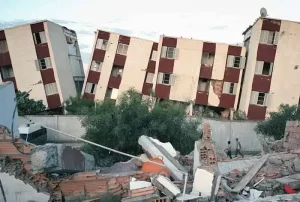Table of Contents
In this article, we will discuss how are earthquakes measured.
An earthquake may be defined as the sudden shock of the earth that emits the energy in the earth’s lithosphere causing the formation of seismic waves.
1. How are Earthquakes Measured?
The earthquake can be caused due to volcanic eruption, moving of tectonic plates, formation of the cave in a small area, or due to explosions. It is determined with the help of a seismograph by seismometers and is measured on the Richter Magnitude Scale.
2. Seismometers
A seismometer is the inner component of the seismograph, which may be a pendulum or a mass attached to a spring.
It is usually utilized synonymously with “seismograph”. Seismographs are devices utilized to measure the motion of the ground during the time of an earthquake.
3. Seismograph
The seismograph can measure the strength and duration of the earthquake’s waves. A seismograph is a primary earthquake recording device. The seismograph makes a digital graphic measuring the ground motion by the seismic waves. The digital measuring device is called a seismogram.
When seismic data is taken from a minimum of three different places, it can be utilized to calculate the epicenter by where it crosses.

4. Ways of Measuring Earthquakes
Here are the 4 ways the earthquakes are measured:
a. Wave Amplitude, Fault Size, Amount of Slip
b. The Richter Scale
c. The Moment Magnitude Scale
d. The Mercalli Scale
a. Wave Amplitude, Fault Size, Amount of Slip
There are several ways to determine the magnitude of an earthquake. Most scales depend upon the amplitude of seismic waves measured on seismometers. These scales account for the interval between the earthquake and the recording seismometer so that the determined magnitude should be about the similar no matter where it is recorded.
Another scale depends on the physical size of the earthquake fault and the amount of slip that takes place. Then there are also compute of earthquake shaking intensity. The intensity of one earthquake ranges majorly from place to place.

b. The Richter Scale
The majorly utilized method, the Richter scale, was introduced by Charles F. Richter in 1934. It utilizes a formula that depends upon the amplitude of the largest wave measured on a specific type of seismometer and the distance between the earthquake and the seismometer.
That scale was fixed to California earthquakes and crust; other scales, depending upon wave amplitudes and total earthquake time span, were introduced for utilization in other conditions and they were prepared to be uniform with Richter’s scale.

c. The Moment Magnitude Scale
The moment magnitude scale uses the fault’s geometry (the angle and other elements of the plane that distinguish the fault that ruptures at the time of an earthquake) and the earthquake’s seismic moment (the movement of the fault across its whole area product by the force utilized to displace the fault).

d. The Mercalli Scale
The Mercalli scale is another method to determine the strength of an earthquake is it utilizing the observations of the people who felt the earthquake, and the quantity of damage that took place, to calculate its intensity. The Mercalli scale was introduced to do just that. The scale was introduced by Giuseppe Mercalli in 1902 and was changed by Harry Wood and Frank Neumann in 1931 to make what is now known as the Modified Mercalli Intensity Scale. To support it by differentiating it from magnitude scales, the MMI scale utilizes Roman numerals.
The Mercalli scale does not utilize scientific devices to calculate seismic waves, it has been very beneficial for knowing the damage taken due to large earthquakes. It has also been utilized majorly to explore earthquakes that took place before there were seismometers.
Some elements that affect the quantity of damage that occurs are
a. Size (magnitude) of the earthquake
b. Distance from the epicenter
c. Depth of the earthquake,
d. Building (or other structure) design,
e. Type of surface material the buildings lie on.
| Intensity | Shaking | Damage |
|---|---|---|
| I | Not Felt | Not detected except by a very few under especially favorable conditions. |
| II | Weak | Detected only by fewer persons at rest, especially on upper floors of buildings. Swing of suspended objects. |
| III | Weak | Detected fully by persons indoors, especially on upper floors of buildings. Many people do not take it as an earthquake. Standing motor cars may rock a bit. Vibration is the same as the passing of a truck. Duration is known. |
| IV | Light | Detected indoors by a huge crowd, outdoors by few during the day. Dishes, windows, and doors are disturbed; walls give a cracking sound. Feels like a heavy truck striking building. Standing motor cars rocked slightly. |
| V | Moderate | Detected by almost everyone; many come out. Some brittle materials like windows and glass were broken. Unbalanced objects overturned. Pendulum clocks may fall. |
| VI | Strong | Detected by all, many were afraid. Some weighted furniture was displaced; a few cases of fallen plaster. Less Damage. |
| VII | Very Strong | Less Damage in buildings of good design and construction; a bit normal in well-built structures; notable damage in badly constructed or poorly planned structures; some chimneys were collapsed. |
| VIII | Severe | Less damage in specially planned structures; Notable damage in a normal substantial house with the collapse in few parts. Damage is high in badly constructed structures. Fall of chimneys, factory stacks, columns, monuments, walls. Heavy furniture overturned. |
| IX | Violent | Damage considerable in specially designed structures; well-designed frame structures thrown out of plumb. Damage is great in substantial buildings, with partial collapse. Buildings shifted off foundations. |
| X | Extreme | Few well-built wooden elements were damaged; most masonry and frame structures were damaged with foundations. Rail bent. |
| Read More: Emergency Supplies Needed During Earthquakes |

